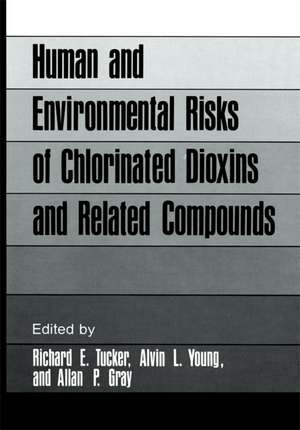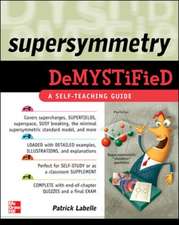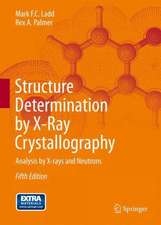Human and Environmental Risks of Chlorinated Dioxins and Related Compounds: Environmental Science Research, cartea 26
Autor Richard E. Tuckeren Limba Engleză Paperback – 23 noi 2011
Din seria Environmental Science Research
-
 Preț: 405.28 lei
Preț: 405.28 lei - 15%
 Preț: 583.75 lei
Preț: 583.75 lei -
 Preț: 413.76 lei
Preț: 413.76 lei -
 Preț: 386.81 lei
Preț: 386.81 lei -
 Preț: 391.61 lei
Preț: 391.61 lei -
 Preț: 403.53 lei
Preț: 403.53 lei -
 Preț: 398.74 lei
Preț: 398.74 lei -
 Preț: 405.06 lei
Preț: 405.06 lei -
 Preț: 397.59 lei
Preț: 397.59 lei -
 Preț: 410.66 lei
Preț: 410.66 lei -
 Preț: 410.88 lei
Preț: 410.88 lei -
 Preț: 391.02 lei
Preț: 391.02 lei - 15%
 Preț: 656.25 lei
Preț: 656.25 lei - 18%
 Preț: 1253.54 lei
Preț: 1253.54 lei - 15%
 Preț: 602.40 lei
Preț: 602.40 lei - 5%
 Preț: 387.58 lei
Preț: 387.58 lei -
 Preț: 409.89 lei
Preț: 409.89 lei -
 Preț: 406.80 lei
Preț: 406.80 lei -
 Preț: 415.29 lei
Preț: 415.29 lei -
 Preț: 405.53 lei
Preț: 405.53 lei -
 Preț: 394.29 lei
Preț: 394.29 lei -
 Preț: 406.05 lei
Preț: 406.05 lei -
 Preț: 403.15 lei
Preț: 403.15 lei -
 Preț: 409.13 lei
Preț: 409.13 lei -
 Preț: 433.36 lei
Preț: 433.36 lei -
 Preț: 399.50 lei
Preț: 399.50 lei - 15%
 Preț: 592.07 lei
Preț: 592.07 lei -
 Preț: 391.02 lei
Preț: 391.02 lei -
 Preț: 395.85 lei
Preț: 395.85 lei - 5%
 Preț: 1106.33 lei
Preț: 1106.33 lei -
 Preț: 391.79 lei
Preț: 391.79 lei - 5%
 Preț: 378.97 lei
Preț: 378.97 lei -
 Preț: 395.09 lei
Preț: 395.09 lei - 15%
 Preț: 670.82 lei
Preț: 670.82 lei -
 Preț: 395.85 lei
Preț: 395.85 lei - 5%
 Preț: 720.31 lei
Preț: 720.31 lei -
 Preț: 452.04 lei
Preț: 452.04 lei - 18%
 Preț: 1834.77 lei
Preț: 1834.77 lei -
 Preț: 399.50 lei
Preț: 399.50 lei - 18%
 Preț: 953.20 lei
Preț: 953.20 lei - 15%
 Preț: 664.61 lei
Preț: 664.61 lei - 18%
 Preț: 951.77 lei
Preț: 951.77 lei -
 Preț: 389.31 lei
Preț: 389.31 lei - 18%
 Preț: 947.98 lei
Preț: 947.98 lei
Preț: 426.06 lei
Nou
Puncte Express: 639
Preț estimativ în valută:
81.54€ • 88.54$ • 68.49£
81.54€ • 88.54$ • 68.49£
Carte tipărită la comandă
Livrare economică 22 aprilie-06 mai
Preluare comenzi: 021 569.72.76
Specificații
ISBN-13: 9781461336013
ISBN-10: 1461336015
Pagini: 852
Ilustrații: XII, 823 p.
Dimensiuni: 170 x 244 x 45 mm
Greutate: 1.31 kg
Ediția:Softcover reprint of the original 1st ed. 1983
Editura: Springer Us
Colecția Springer
Seria Environmental Science Research
Locul publicării:New York, NY, United States
ISBN-10: 1461336015
Pagini: 852
Ilustrații: XII, 823 p.
Dimensiuni: 170 x 244 x 45 mm
Greutate: 1.31 kg
Ediția:Softcover reprint of the original 1st ed. 1983
Editura: Springer Us
Colecția Springer
Seria Environmental Science Research
Locul publicării:New York, NY, United States
Public țintă
ResearchCuprins
Definition of the Problem.- Dioxins as Contaminants of Herbicides: The U. S. Perspective.- Dioxins as Contaminants of Herbicides: Australian Perspective.- The Use of Scientific Information in the Development of Public Policies.- Regulatory Actions on Dioxins and Related Compounds.- Dioxins and Related Compounds as International Issues of Concern.- Analytical Chemistry.- Analytical Methodology for the Determination of PCDDs and PCDFs in Products and Environmental Samples: An Overview and Critique.- High Resolution Mass Spectrometry Methods of Analysis for Chlorinated dibenzo-p-dioxins and dibenzofurans.- Determination of tetrachlorodibenzo-p-dioxins and tetra-chlorodibenzofurans in Environmental Samples by High Performance Liquid Chromatography, capillary gas chromatography and High Resolution Mass Spectrometry.- Methodology and Preliminary Results for the Isomer-Specific Determination of TCDDs and Higher Chlorinated Dibenzo-p-dioxins in Chimney Particulates from Wood-Fueled Domestic Furnaces Located in Eastern, Central, and Western Regions of the United States.- Sampling and Analytical Methodologies for PCDDs and PCDFs in Incinerators and Wood Burning Facilities.- Comparative Monitoring and Analytical Methodology for 2,3,7,8-TCDD in Fish.- Environmental Chemistry.- Emissions of PCDDs and PCDFs from Combustion Sources.- Changes in Dioxin Isomer Group Ratios in the Environment: An Update and Extension of the Present Theory.- Analyses for 2,3,7,8-Tetrachlorodbenzo-p-dioxin Residues in Environmental Samples.- Long-Term Studies on the Persistence and Movement of TCDD in a Natural Ecosystem.- Microbial Degradation of TCDD in a Model Ecosystem.- Residues of Polychlorinated Dibenzo-p-dioxins and Dibenzo-furans in the Laurentian Great Lakes Fish.- Identification of Polychlorinated Dioxins (PCDDs) and Dibenzofurans (PCDFs) in Human Samples, Occupational Exposure and Yusho Patients.- Seveso — An Environmental Assessment.- Environmental Toxicology.- Environmental Toxicity of TCDD.- The Theory of Accumulation and Its Relationship to the Choice of Monitoring Matrices for Dioxins.- A Field Study of Soil and Biological Specimens from a Herbicide Storage and Aerial-Test Staging Site Following Long-Term Contamination with TCDD.- Chick Edema Disease and Hepatic Porphyria in Lake Ontario Herring Gull Embryos in the Early 1970s.- Long-Term Field Studies of a Rodent Population Continuously Exposed to TCDD.- Ultrastructural Comparison of Liver Tissues from Field and Laboratory TCDD-Exposed Beach Mice.- Biochemistry and Metabolism.- PCDDs and Related Compounds: Metabolism and Biochemistry.- 2,3,7,8-Tetrachlorodibenzo-p-Dioxin-Induced Weight Loss: A Proposed Mechanism.- Studies of the Mechanism of Action of Hepatotoxicity of 2,3,7,8-Tetrachlorodibenzo-p-dioxin (TCDD) and Related Compounds.- The Ah Receptor: A Specific Site for Action of Chlorinated Dioxins?.- Genetic Differences in Enzymes Which Metabolize Drugs, Chemical Carcinogens, and Other Environmental Pollutants.- Factors Affecting the Disposition and Persistence of Halogenated Furans and Dioxins.- Adipose Tissue Storage of Polychlorinated Compounds.- Structure Elucidation of Mammalian TCDD-Metabolites.- Animal Toxicology.- Absorption, Distribution and Metabolism of 2,3,7,8-Tetra-chlorodibenzodioxin (TCDD) in Experimental Animals.- Morphology of Lesions Produced by the Dioxins and Related Compounds.- A Consideration of the Mechanism of Action of 2,3,7,8-Tetra-chlorodibenzo-p-dioxin and Related Halogenated Aromatic Hydrocarbons.- Human Observations.- Methodology of Clinical Studies on ExposedPopulations.- A Mortality Study of Workers Employed at the Monsanto Company Plant in Nitro, West Virginia.- Dioxin and Reproductive Events.- Significance of Cutaneous Lesions in the Symptomatology of Exposure to Dioxins and Other Chloracnegens.- Soft Tissue Sarcomas: Clues and Caution.- Risk Assessment.- Risk Assessment: Introductory Remarks.- Assessing Risk in Legal Proceedings: How to Deal With Scientific Uncertainty in Toxic Substances Risk Assessments.- Some General Observations on the Safety of PCDDs.- Risk Assessment for Regulation of Dioxin (TCDD).- Risk Assessment for 2,3,7,8-Tetrachlorodibenzo-p-dioxin (TCDD).- Laboratory Safety and Waste Management.- An Overview of Laboratory and Waste Management Guidelines for Toxic Chlorinated Dibenzo-p-dioxins and Dibenzofurans.- Laboratory Design Considerations for the Handling and Analysis of Chlorinated Dioxins and Related Compounds.- Safe Handling of Toxic Chemicals: Perspectives of a Bench Chemist and Laboratory Manager.- Safety Precautions for the Handling of TCDD.- A Program for Monitoring Potential Contamination in the Laboratory Following the Handling and Analyses of Chlorinated Dibenzo-p-dioxins and Dibenzofurans.- A Medical Surveillance Program for Scientists Exposed to Dioxins and Furans.- Laboratory Handling and Disposal of Chlorinated Dioxin Wastes.- Physical and Chemical Properties of Dioxins in Relation to their Disposal.- The Design, Implementation and Evaluation of the Industrial Hygiene Program Used During the Disposal of Herbicide Orange.- Panel Reports.- Analytical Chemistry.- Environmental Chemistry.- Environmental Toxicology.- Biochemistry and Metabolism.- Animal Toxicology.- Human Observations.- Laboratory Safety and Waste Management.- Author Index.










